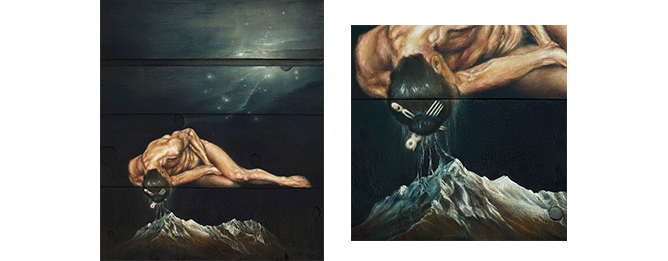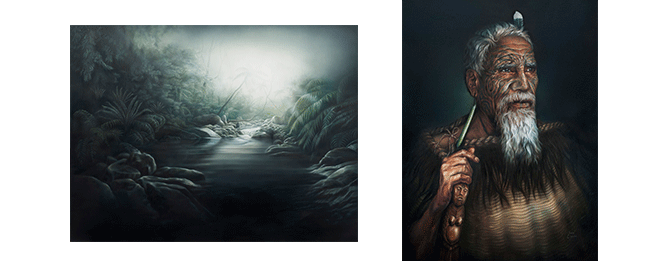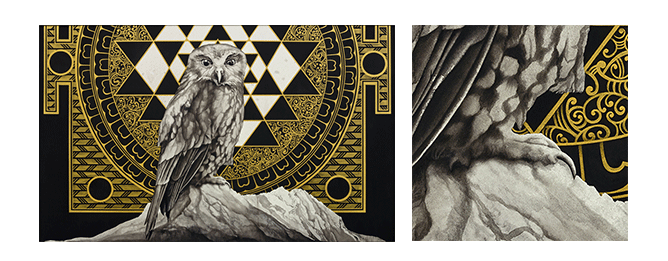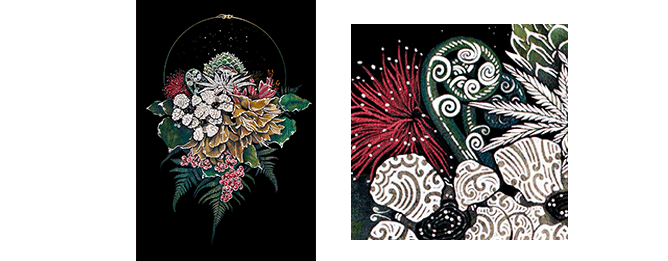Each year, on April 20th, Earth Day calls for a united recognition of and commitment to environmental protection.
From the first Earth Day in 1970, the movement has evolved to become a powerful event, inspiring climate action and transformative change.
As we celebrate the 50th Anniversary of Earth Day, we pause to acknowledge the importance of this day – realised by the collective action and healing currently taking place around the world.
Knowledge and protection of the earth is central to Māori culture, and to the worldview of many indigenous peoples. For centuries, ingdigenous cultures have interwoven their genealogy and creation stories together with their understanding of the natural world.
Earth Day reminds us of Māori understandings of Te Ao (the Earth) and the importance of kaitiakitanga that is explored throughout Sofia’s paintings.
Join us as we honour the message of Earth Day through Sofia Minson’s work
Whakapapa Origins
Whakapapa is Māori genealogy and identity, grounding and intimately connecting a person back to their hapu, their iwi, their ancestors, the whenua, and the cosmos.
Whakapapa Origins is a dream-like exploration of the creation myth. The sky father Ranginui can be seen as the stars above, and the earth mother Papatūānuku takes the form of Ngāti Porou’s sacred maunga, Mt Hikurangi. Tāne Mahuta, their son, lies between them in Te Pō, the darkness created between sky and earth as Tāne pushed his mother and father apart to create our world.
This beautiful scene, with Tane depicted naked and almost fetal between the cosmos and the earth, shows both strength and vulnerability. Today, perhaps this reminds us of our own strength and vulnerability, and the need to show both as we endeavour to protect our environment with intimate awareness of our delicate place within it.
Kaitiaki – Landscape & Portrait
Kaitiaki is a two-piece work, a landscape and a powerful portrait, and the two paintings inform each other when placed side-by-side
Kaitiaki – Landscape shows a river running through a native forest, bathed in ethereal light. A feeling of life in harmony is created, reminding us of a Māori whakatauki (proverb):
"The forest is a living thing just as I breathe and live.
Every leaf, every tree, every insect, every bird, feels and knows this.
When I enter its domain, I know I enter the House Of Tāne.
My ancestor who created us all and each one of us.
A face of Io-of-the-Many-Faces."
This knowledge of intimate connection with the whenua, of whakapapa, is central to the Tikanga Māori principle of being kaitiaki. To be kaitiaki is to protect and nurture the land, not from a place of power or ownership, but as a humble steward acknowledging our place within Papatūānuku as the earth mother.
Kaitiaki – Portrait shows Sofia Minson’s homage to the famous romanticism of Goldie and Lindauer portraits of Māori. The portrait of an old man, proudly wearing his Tā Moko Kanohi (full face tattoo) is thought by the artist as a manifestation of Tāne himself.
Alongside Earth Day, the significance of kaitiakitanga has grown with our recognition of climate change and environmental destruction, as tangata whenua across Aotearoa lead initiatives to restore their environment and culture – combining ancestral knowledge with modern strategies.
Ruru
Ruru is an intriguing and powerful painting that is rich with cross-cultural symbolism. Three potent figures, the Sri Yantra, the Ruru, and Mt Hikurangi, come together to signal our awakening consciousness as the veil between worlds – divine and mortal, traditional and modern, natural and urban – is lifted.
Ruru embodies that shift in our collective psyche, as we start to dismantle the old Pākeha philosophy that separated mankind from the environment. This painting honours the rediscovery of our intrinsic connection to the natural world, to Papatūānuku and her consciousness, a recognition that is only more potent today.
While this shift is being felt all over the world on Earth Day, knowledge of our connection within the land is fundamental to Māori knowledge – the natural world is interwoven within one’s whakapapa, or spiritual ancestry.
Rongoā
Suspended in the blackness of Te Pō is a bouquet of native flowers, plants, and berries from Aotearoa, with a protective manaia symbol positioned above this demonstration of Papatūānuku’s diversity and beauty.
Among many themes, Rongoā speaks to the resurgence of natural healing that has been ignited alongside initiatives to understand and protect our environment. Each plant depicted has a special significance in traditional Māori healing practices.
In light of the global pandemic that parallels Earth Day, this time has highlighted our respect for health and reliance upon modern medicine, Rongoā calls us to remember these ancient practices that were developed by tangata whenua in close connection with Papatūānuku.






